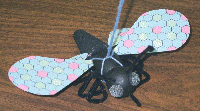Audrey 3rd hour

Polygonisis hexagonia
Sunlight broke over the horizon filling the meadow with a warm yellow glow. The dew on the tall grasses glistened as they swayed to and fro in the morning breeze. Birds soared above looking for breakfast, mice scurried over the ground below. Morning doves cooed in the distance and the bullfrogs down by the pond croaked loudly. Crickets hidden in the grasses added their section to the morning symphony. And a pastel-winged butterfly fluttered past the flowers of a buttercup.
* * *
Polygonisis hexagonia, commonly knows as the hexagon butterfly, is a small butterfly with a segmented black body and pastel wings. The body is constructed of many different geometrical figures. The head is a sphere, the thorax egg-shaped, and the abdomen is a cone. The legs fold into triangles during flight, and its compound eyes are half-spheres, the individual sections of them being hexagons. The wings are equilateral triangles with a half circle attached to them. They are a tessellation of light green, blue, and pink hexagons on the inside, on the outside they are black. When hexagonia closes its wings it looks like a flat, black rock or a dead leaf, providing great camouflage.
The hexagon butterfly is shaped in this way because of nature. The order Lepidoptera, which includes moths and butterflies, have two pairs of wings, the back pair is smaller. Another distinguishing feature of Lepidoptera is the small scales that coat its wings and body (the dust that you find on your hands after handling a butterfly). These butterflies and moths also have an interesting mouthpiece - a proboscis. This straw-like mouth is kept in a spiral under the Lepidoptera's head, unfurled when needed.
This species of butterfly is found in temperate meadows in mid-eastern United States. Hexagonia drinks the nectar from flowers using its proboscis it extends deep into a flower to get to the nectar. Some flowers are not large enough to land on and the butterfly must hover over them. The hexagon butterfly's wing shape allows it to hover over a flower and keep a steady position while drinking the nectar. Its wings also allow it to fly swiftly, resisting changes in wind.
* * *
The pastel-winged butterfly hovers over the buttercup, uncurling its proboscis to eat the nectar. Overhead, a hungry sparrow circles looking for its breakfast. The butterfly, oblivious to anything but its own doings, hovers innocently as the sparrow dives down, its beak open. Seconds later there is nothing left of the beautiful little pastel-winged butterfly but a bit of dust on the buttercup. Polygonisis hexagonia is a victim of the food chain.
Complete Bibliography for the Geometry Bug Project
1. Dr. Math, FAQ: Polygon Names Copywrite 1994-9 The Math Forum
2. Angles Last updated on 4.8.98 by Cheryl Beth Miller
3. Microsoft Encarta Encyclopedia 1999
4. How Grasshoppers' Legs Work WJ Heitler, University of St. Andrews
5. Frank Lloyd Wright in Oak Park, Illinois Copywrite 1995-9 Steve Hurder
6. Frank Lloyd Wright No author given, no update date given.
7. Biology: Concepts and Connections, Second Edition Copywrite 1997 Benjamin/Cummings Publishing (an imprint of Addison Wesley Longman Publishing)
Project
Description
Research
Questions
Student Work